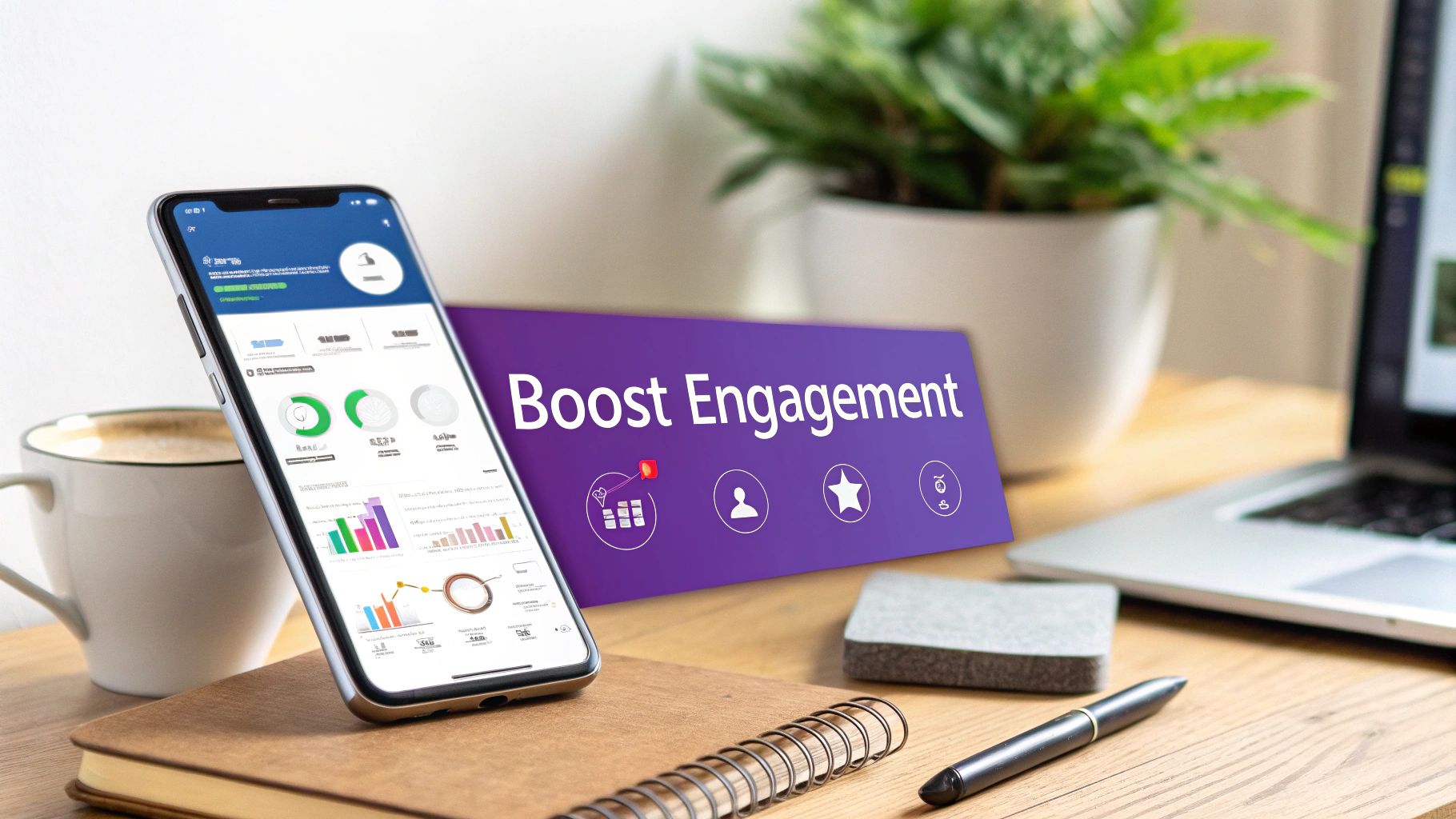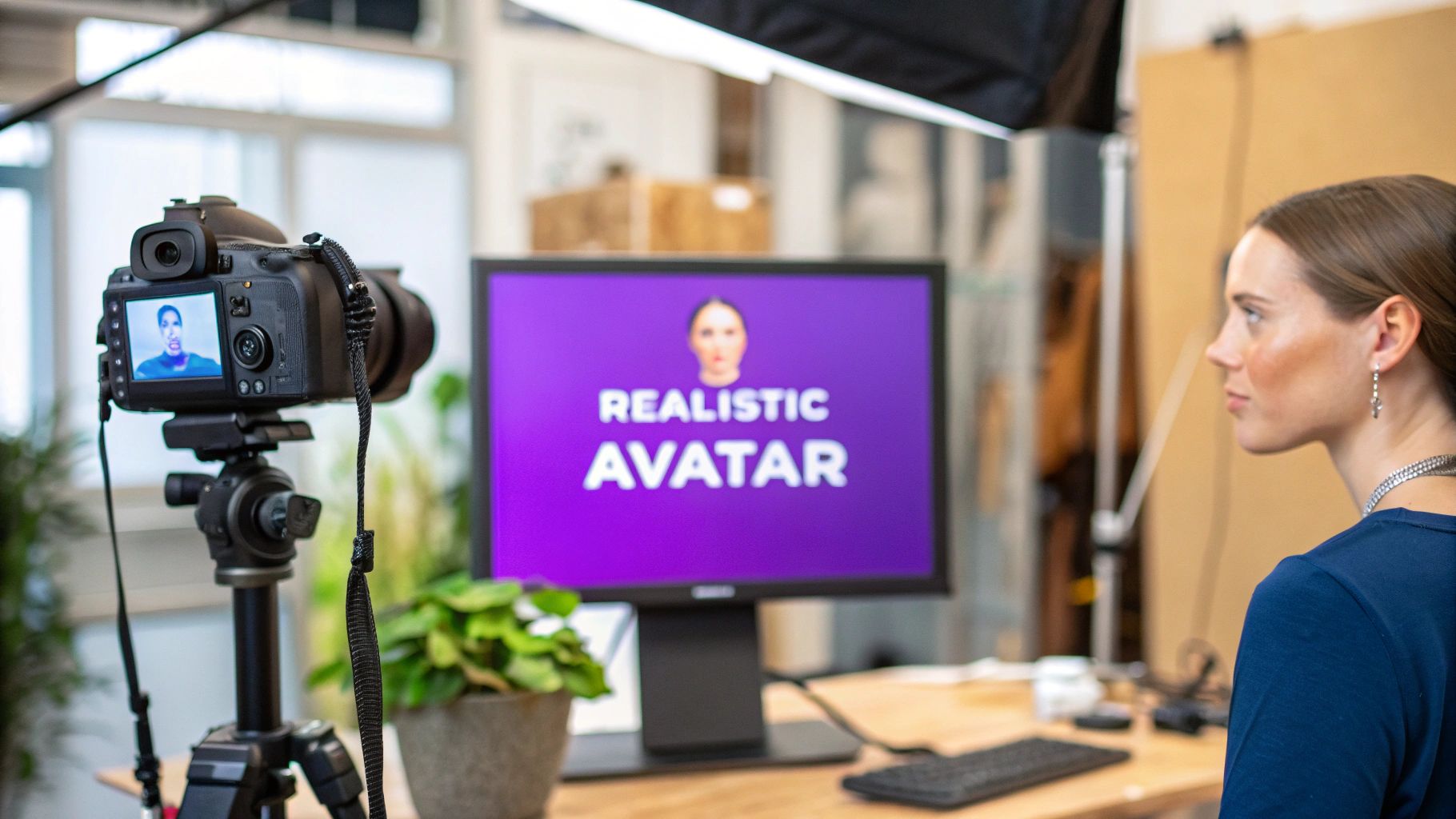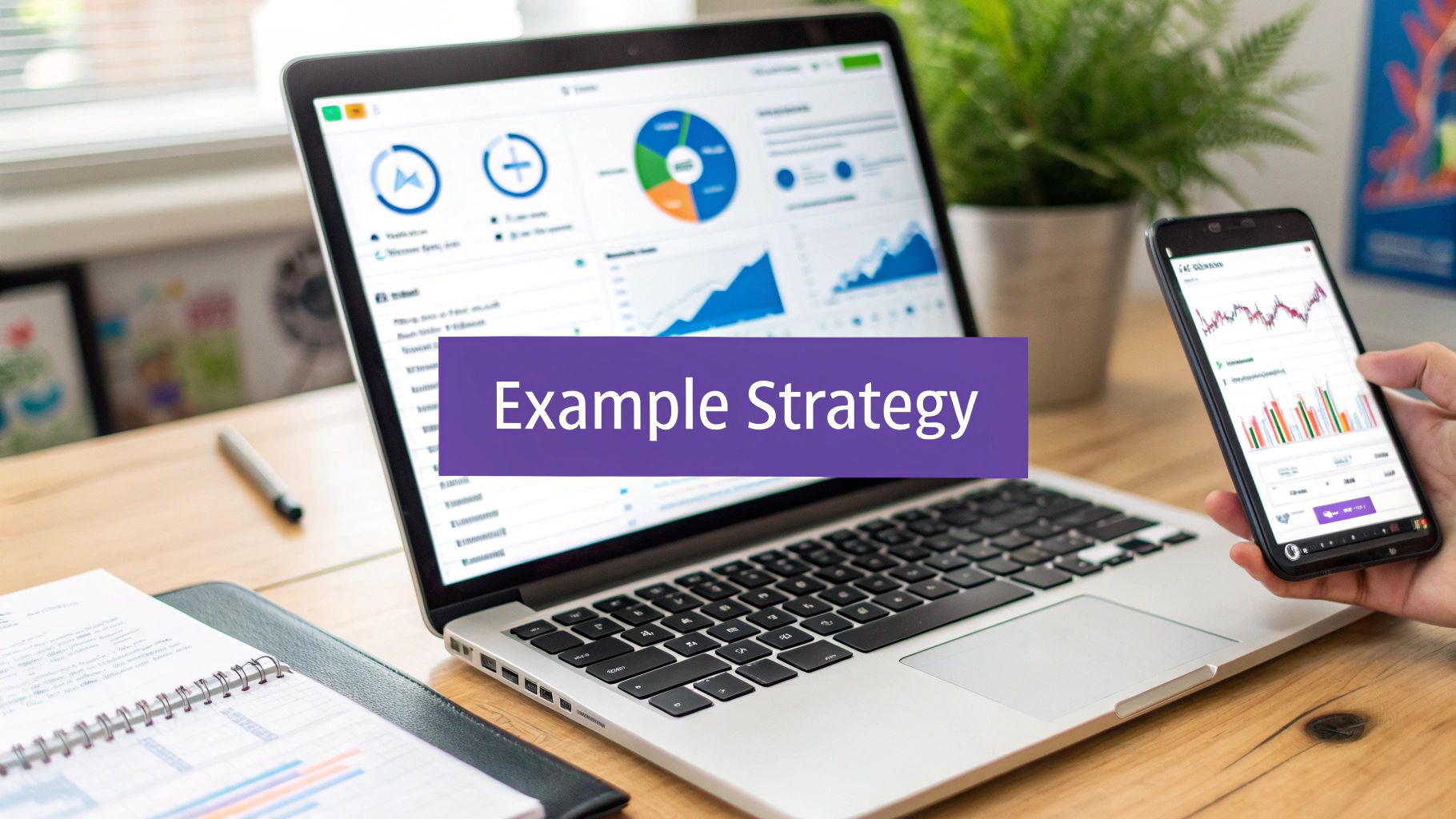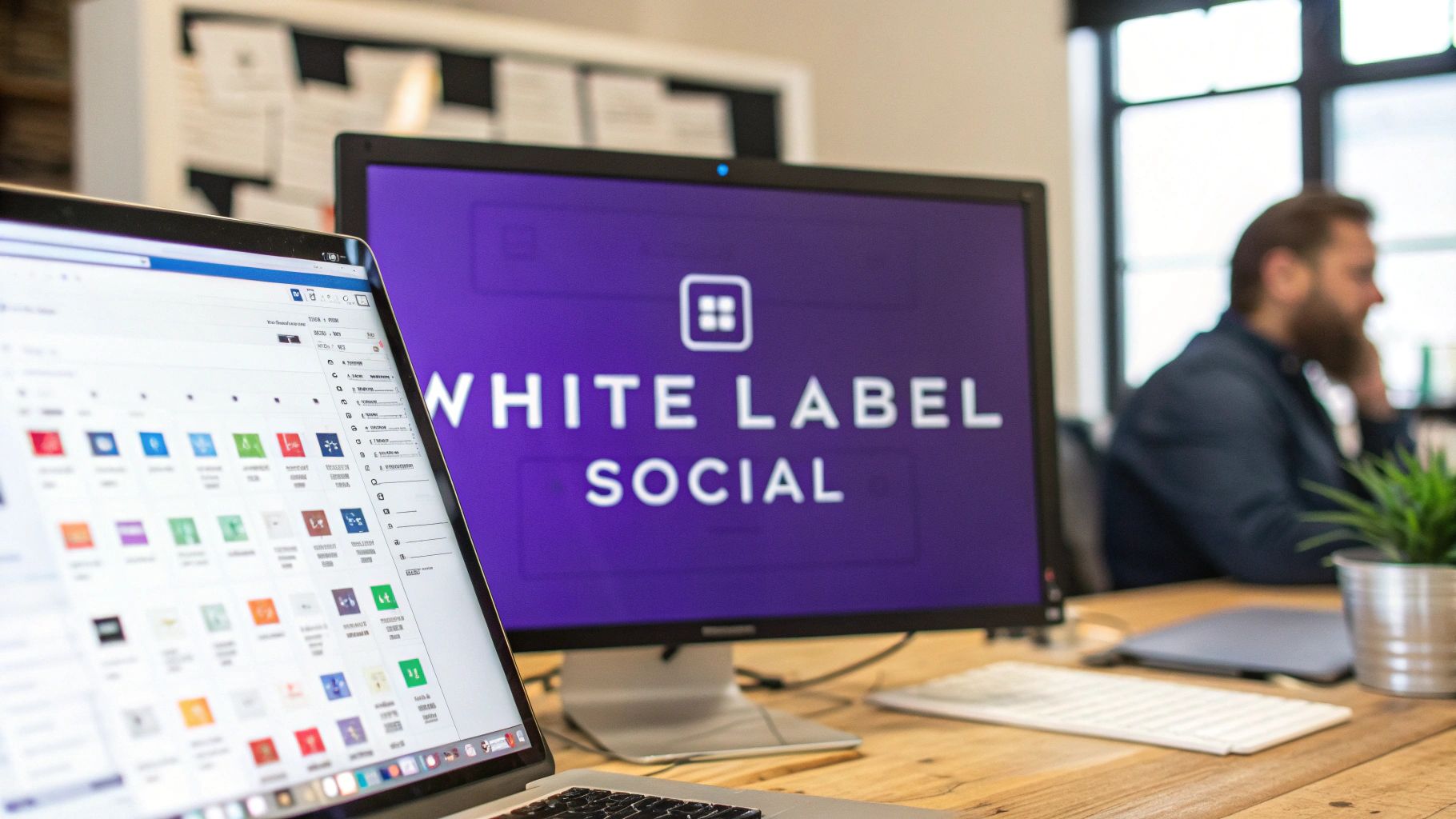AI Social Media Content Creation Done Right

When people talk about AI in social media, they’re really talking about using smart tools to help ideate, draft,optimize, and distribute content way more efficiently. It’s not about firing your marketing team. It's about giving them a serious upgrade—an assistant that offers speed and data-driven ideas so they can produce better work, faster.
Why AI Is Your New Social Media Copilot
Let's get one thing straight: AI isn't just another shiny object for marketers. It's quickly becoming the new operational standard for social media teams that actually want to win.
The days of staring at a blank content calendar, painstakingly resizing a single image for five different platforms, and throwing content at the wall to see what sticks? Those are fading fast. AI is stepping up to be the indispensable copilot every modern marketer needs.
We're moving past the initial hype and into real-world, practical uses. Tools built on powerful models like GPT-4 are genuinely changing daily workflows. They act as a tireless brainstorming partner, instantly smashing through the creative blocks that bring teams to a screeching halt. Imagine coming up with ten different angles for a new product announcement in less than 60 seconds. That’s the kind of power we’re talking about.
Immediate Wins from Integrating AI in Your Workflow
Adopting AI for social media isn't some far-off, futuristic goal; the benefits are immediate and tangible. For marketers, it means a fundamental shift from manual grunt work to strategic, high-impact tasks. Here’s a quick look at the direct benefits you can expect.
| Benefit | Description | Practical Impact |
|---|---|---|
| Drastic Efficiency Boost | Automates repetitive, time-consuming tasks like drafting, resizing, and scheduling. | Frees up hours each week, allowing your team to focus on strategy, community engagement, and creative oversight. |
| Enhanced Creativity | Acts as an endless source of ideas, angles, and formats for your content. | Eliminates "writer's block" and introduces fresh perspectives you might not have considered, keeping your content vibrant. |
| Scalable Content Output | Enables you to produce a high volume of quality content without increasing your team's size or budget. | Maintain a consistent presence on all platforms, test more campaigns, and respond to trends faster without burning out your team. |
Ultimately, integrating AI is about empowering your team to work smarter, not harder. The result is a more agile, creative, and effective social media strategy that drives real business outcomes.
Scale Your Output Without Burning Out
One of the most immediate game-changers is scalability. AI lets you generate a high volume of solid first drafts, liberating your team to focus on the high-level work—strategic tweaks, creative flourishes, and final polish—instead of starting from a blank page every single time.
This means you can finally maintain that ambitious, consistent posting schedule across all your channels without proportionally piling on the workload.
By 2025, AI has cemented its role in social media content creation, fundamentally reshaping how content gets made. Businesses are leaning heavily on AI-driven platforms like OpenAI's GPT-4, Jasper, and Copy.ai to generate everything from ad copy to social media updates. This shift is all about reducing manual effort and dramatically speeding up production, which is a huge win for any team trying to keep up.
Maintain a Consistent Brand Voice
Keeping a brand’s personality consistent across the professional tone of LinkedIn, the rapid-fire nature of X (formerly Twitter), and the visual-first world of Instagram is a constant battle. This is where AI really shines. It can learn your brand’s unique tone, style, and messaging rules.
Think of AI as your brand’s ever-vigilant guardian. Feed it your best-performing posts, a clear style guide, and your core messaging. From that point on, it will generate new drafts that already sound like you. This ensures every single post, whether it’s written by a new intern or a senior manager, feels perfectly on-brand.
This consistency is a cornerstone of building a powerful online presence. If you want to go deeper on this, our complete social media branding guide is packed with tips for carving out a voice that truly stands out.
At the end of the day, this isn't about handing the keys over to a robot. It’s about giving your team the tools to turn an overwhelming content calendar into a manageable, strategic asset that drives real, measurable results.
Building Your AI-Powered Content Engine
Creating an AI system for social media isn't about finding one magic tool; it's about building a repeatable process. Think of it as an engine. Once you build it, it consistently churns out on-brand content, freeing you up to focus on high-level strategy instead of the daily grind of figuring out what to post.
The foundation of this engine isn't technology—it's clarity. Before you write a single prompt, you need sharp, clear goals for each social channel. Are you using LinkedIn for lead generation? Instagram for brand awareness? X (formerly Twitter) for community engagement? Each goal demands a completely different style and tone.
Choosing Your Core AI Toolkit
With your goals locked in, you can start picking the right tools for the job. Not all AI platforms are created equal, and your choice really depends on your specific needs and budget. A startup founder, for instance, might lean on a text generator like MakerBox to draft professional LinkedIn posts. In contrast, a B2C brand will likely need a video tool to create catchy Instagram Reels.
Your toolkit should cover these three core areas:
- Text Generation: Tools like Jasper or Copy.ai are fantastic for drafting initial post copy, spinning up multiple variations, and adapting the tone for different platforms.
- Visual Creation: When it comes to generating images, platforms like Midjourney or DALL-E 3 are the industry leaders. They can turn simple text prompts into genuinely compelling visuals.
- Video Production: To really complete your content engine, it’s worth understanding the guide to AI video generator technology. Tools like Synthesia or InVideo are changing the game for creating video content at scale.
This graphic shows just how much more efficient you can be when AI tools generate social media drafts from a single, centralized workspace.
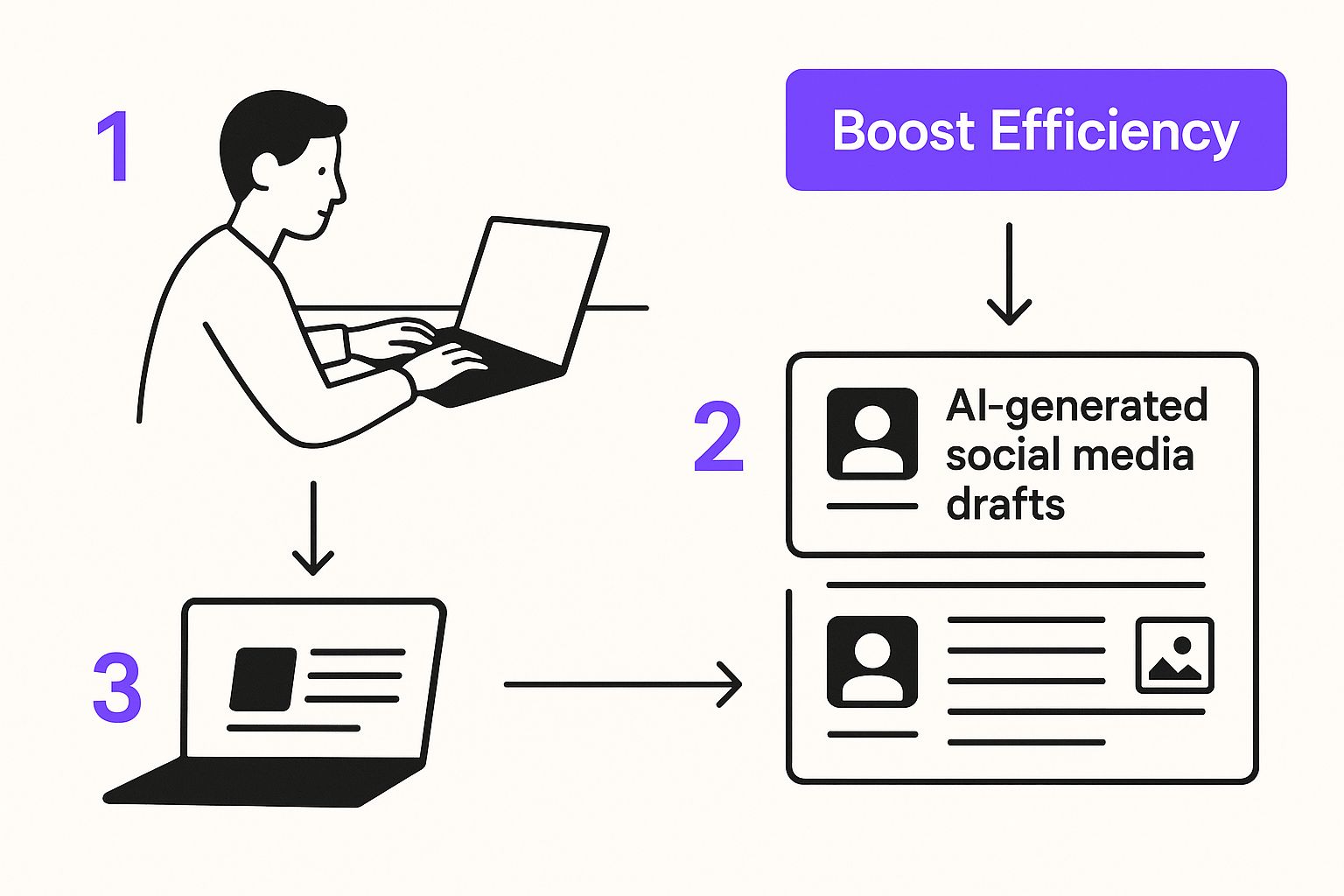
The key takeaway here is centralization. Using integrated tools stops the fractured, inefficient workflows that slow marketing teams down. This is the first real step to enhance online presence with a strategy that actually works.
Crafting Platform-Specific Prompts
The quality of your AI-generated content is directly tied to the quality of your prompts. If you give it generic prompts, you'll get generic results. It's that simple. Effective prompting means giving the AI specific context and clear constraints.
The secret to great AI output is treating the AI like a new marketing assistant. You wouldn't just tell them to "write a post." You'd give them the target audience, the key message, the desired tone, and examples of what works.
For example, a vague prompt like, "Write a LinkedIn post about our new software," is pretty weak. It leaves far too much to chance.
A much stronger prompt looks something like this: “Act as a B2B marketing expert. Write a 150-word LinkedIn post for an audience of startup founders. Announce our new project management software, ‘TaskFlow.’ Focus on its key benefit of saving 10 hours per week. Use a professional but approachable tone and include three relevant hashtags.”
See the difference? This level of detail is what turns a basic AI tool into a powerful content engine. It ensures every single post has a clear purpose and speaks directly to your ideal customer. By systemizing your goals, tools, and prompts, you create a reliable workflow that consistently delivers results.
Generating Endless Ideas with Your AI Partner
We’ve all been there—staring at a blank content calendar, feeling that familiar sense of dread. This is exactly where AI stops being a buzzword and becomes your go-to problem-solver. Forget the struggle. Think of your AI as a tireless brainstorming partner, always ready to dig up fresh ideas on demand.
The first move is to get specific. Don't just ask for "post ideas." Instead, start training your AI to think like your competition. Feed it the social media profiles of your top three rivals and prompt it to analyze their best-performing content from the last 90 days. Ask it to pinpoint the common themes, formats, and emotional triggers that are clearly working with your shared audience. Right away, you have a starting point backed by actual data, not just guesswork.
The real magic happens when you treat your AI less like a search engine and more like a junior strategist. The quality of your ideation is directly tied to the quality of your prompts and the context you provide.
From there, you can use these insights to generate your own unique angles. Your AI partner isn't just for drafting; it can be an endless source of fresh social media content ideas, sparking creativity that actually sets you apart. This simple process turns competitor analysis from a boring quarterly report into a real-time idea factory.
Turning Concepts into First Drafts
Once you have a handful of strong concepts, it's time to start drafting. This is where you can see massive efficiency gains. The goal here should be to get a draft that's about 80% complete. This frees you up to spend your valuable time on the important stuff—refining the message and injecting your brand's voice—not starting from a blank page.
Let's take a concept like "a day in the life of a remote software developer." You can prompt your AI to create tailored drafts for different platforms.
- For X (formerly Twitter): "Generate a 5-tweet thread based on the 'day in the life' concept. Use a witty, slightly sarcastic tone. Make sure the first tweet has a strong hook and the last one includes a call-to-action."
- For LinkedIn: "Draft a 200-word LinkedIn article from the perspective of a senior developer, focusing on productivity tips and work-life balance from the 'day in the life' concept. The tone should be professional and insightful. Add relevant B2B hashtags."
- For Instagram: "Write three compelling Instagram caption options for a carousel post about the 'day in the life' concept. Keep each caption under 150 characters and end it with an engaging question to spark comments."
Systematizing Your Idea-to-Draft Workflow
This approach creates a powerful, repeatable workflow that keeps your content pipeline flowing. You're no longer just creating one-off posts. You're building a system where a single core idea can be intelligently repurposed across multiple channels, with each version optimized for that specific platform's audience.
This is a core principle of doing AI-powered marketing right. By building these small, efficient systems, you free up the mental space for bigger strategic thinking. This workflow also feeds perfectly into content scheduling. Once your drafts are polished, you can use tools that support automated social media posting to plan out your calendar weeks, or even months, in advance.
This combination of AI-driven ideation, platform-specific drafting, and automated scheduling transforms your content creation process from a reactive chore into a proactive, strategic part of your business. It’s how you consistently show up with valuable content without burning out your team.
Refining Raw AI Content into Brand Gold
Let's be honest: an AI-generated draft is a fantastic starting point, but it's never the finished product. The real magic in AI social media content creation happens when you, the human expert, step in. This is where you transform that generic output into brand gold that actually connects with your audience.
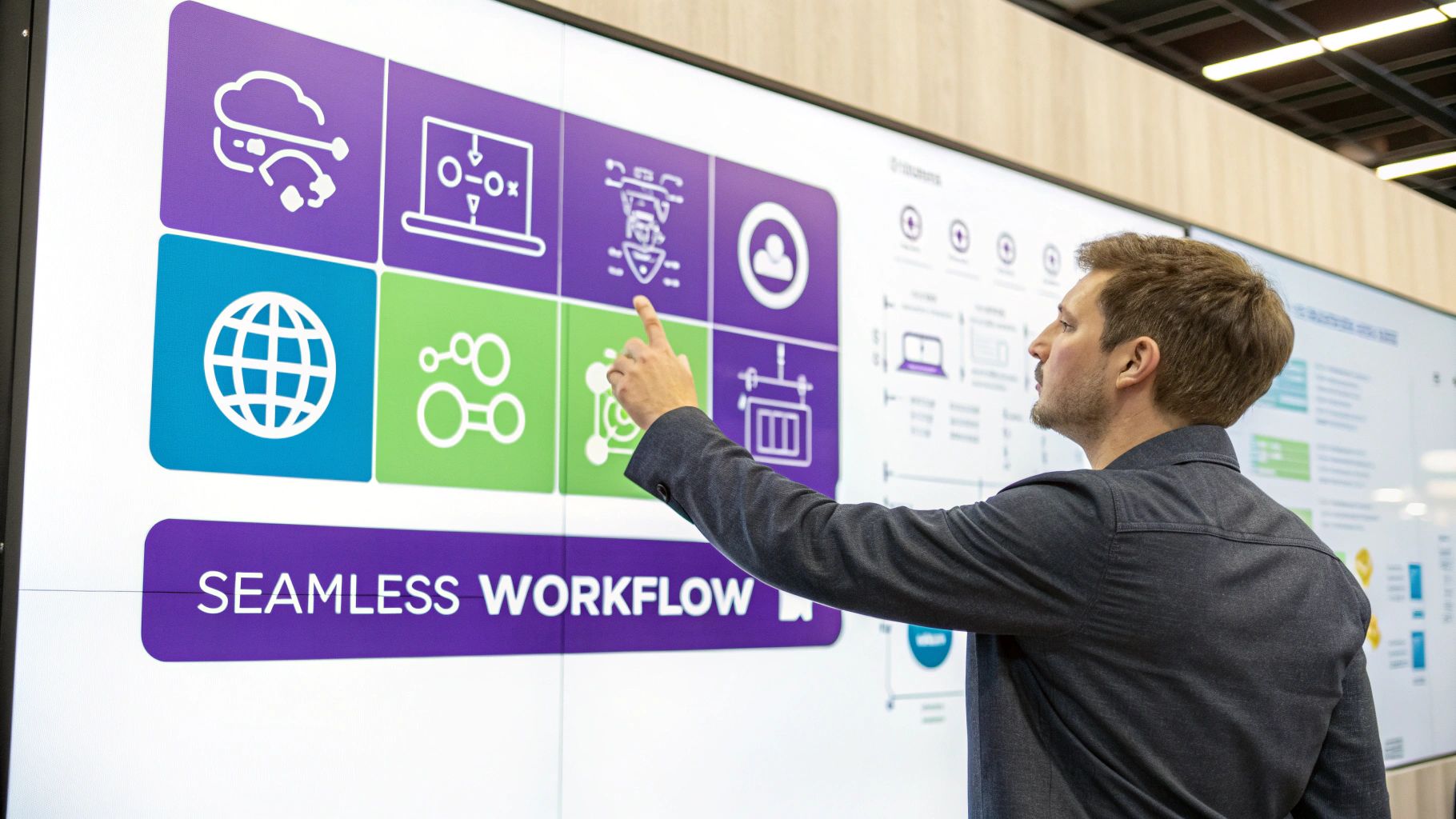
Think of the initial AI draft as raw clay. It has potential, but it's your job to shape it, add texture, and give it a personality that feels like your brand. The first, non-negotiable step? Fact-checking. AI models can "hallucinate" or pull outdated information, so you have to verify every claim, statistic, or fact to protect your credibility.
Once you know the information is solid, it's time to inject your brand's authentic voice. Is your brand witty and informal, or more authoritative and professional? An AI can mimic tone, but it can't replicate your unique perspective or share the personal anecdotes that build genuine rapport.
Humanizing Your AI-Generated Content
This human touch is what turns a decent post into a memorable one. It’s all about weaving in the nuances that make your brand feel relatable and trustworthy. This is especially true for enterprise marketing, where brand consistency isn't just a goal—it's a necessity.
This shift is already happening at scale. In the enterprise world, it's expected that 75% of marketers will be using generative AI in their social media workflows by 2025. This isn’t just about working faster; it’s a strategic move to maintain a consistent brand voice across massive campaigns. You can find more on how AI is changing enterprise content over at Sprinklr.com.
The goal is to edit with empathy. Read the AI-generated text and ask yourself: "Does this sound like a real person from our team wrote it?" If the answer is no, it's time to roll up your sleeves and add your personal stories and insights.
To get there, try these practical techniques:
- Rewrite for emotion: Swap out formal phrasing for more conversational language. For example, turn "The software is efficient" into something like, "You'll be amazed at how much time this saves you."
- Add personal stories: Instead of just listing features, share a quick, relevant anecdote about how a customer found success.
- Ask engaging questions: End your posts with open-ended questions that spark real conversation, not just one-word replies.
Optimizing for Platforms and People
Finally, take that refined content and optimize it for both platform algorithms and specific audience segments. You can absolutely use AI as an assistant here, but your strategic oversight is what makes it work. For instance, you could prompt it to, "Incorporate these three keywords naturally into this LinkedIn draft," or "Suggest five relevant, high-traffic hashtags for this Instagram post."
Personalization is another area where the human touch is irreplaceable. The core message might stay the same, but you should tweak it for different audiences. The value you highlight for a startup founder should be different from what you'd present to a corporate manager. For more inspiration on tailoring your message, check out our guide on social media content ideas.
Ultimately, this blend of AI efficiency and human strategy is the secret to creating high-performing content that feels genuinely human.
Measuring What Matters in Your AI Strategy
Look, creating a bunch of social media content with AI is fun, but if you're not tracking what actually works, you're just throwing spaghetti at the wall. Moving from amateur to pro means knowing whether your efforts are paying off. You have to look past the vanity metrics—likes and shares feel good, but they don't tell the whole story. The real wins are found in the data that connects directly to your business goals.
We're talking about the numbers that actually move the needle: engagement rates, click-through rates (CTRs), conversions, and real audience growth. This is how you figure out if your AI-assisted content is driving people to your website. Are they actually signing up for your newsletter? Are they buying your products? Answering these questions is what separates a gimmick from a strategy.
The results are already speaking for themselves. Roughly 90% of businesses using generative AI are saving a significant amount of time. Even better, 73% are seeing a real jump in engagement rates on their AI-assisted content.
Building a Data-Driven Feedback Loop
The ultimate goal here is to create a smart feedback loop where performance data tells you exactly what to create next. When you notice a certain type of AI-generated post is crushing it with high CTRs, that’s not just a win—it's a roadmap. It’s a bright, flashing sign telling you what your audience wants.
This means your AI prompting needs to get sharper and more informed by data. Instead of a generic prompt like, "a post about our new feature," you can get way more specific. Try something like, "Generate three variations of a LinkedIn post about our new feature, using the same hook structure and call-to-action that drove a 5% CTR on our last campaign." That's how you turn a one-off success into a repeatable system.
Think of your analytics as a direct conversation with your audience. They're telling you, post by post, what they want to see. Your job is to listen and use AI to give them more of it, faster and more effectively.
Using AI to Analyze Performance
The good news is that AI isn't just for content creation; it can be a powerhouse for analysis, too. Many modern analytics platforms use AI to dig up insights you might otherwise miss. They can pinpoint which content formats, topics, and even tones of voice are resonating most with different segments of your audience.
To really dial this in, you should bring in dedicated social media reporting tools. We’ve put together a comprehensive guide on the best social media reporting tools to help you find one that fits your workflow. These tools are built to:
- Identify top-performing content automatically, so you know exactly what to double down on.
- Analyze what your competitors are doing to spot gaps and opportunities you can jump on.
- Track conversions and trace them back to the specific social media posts that drove them.
When you pair AI-powered creation with AI-powered analysis, you create a self-improving content engine. You're no longer just guessing what might work; you're building a system that gets smarter with every single post you publish.
Common Questions About AI in Social Media
Diving into AI for social media always brings up a few questions. It’s smart to be curious and even a little skeptical. This FAQ section cuts through the noise to tackle the most common concerns we hear from marketers. My goal is to give you clear, straightforward answers so you can use these powerful tools with total confidence.

Will AI Content Hurt My Brand's Authenticity?
Not if you use it the right way. The secret is to think of AI as an assistant, not the author. Authenticity isn't lost when AI helps you brainstorm or draft; it's lost when a human forgets to add those final, crucial touches that make it you.
Your brand's authentic voice comes from your unique stories, your specific viewpoint, and your real insights. Always use a "human-in-the-loop" approach. You refine the AI's initial output, making sure every post truly reflects your brand's values before it ever goes live.
What Are the Biggest Mistakes to Avoid?
The number one mistake I see is the "publish without proofreading" trap. Never, ever take raw AI output and post it directly to your social channels. That’s a recipe for embarrassing typos, off-brand messaging, or even factual errors that can sink your credibility.
Another common pitfall is using lazy, generic prompts. A vague request like "write a post about marketing" is going to give you vague, uninspired results. The more specific context you provide—about your audience, your goals, and your key messages—the better the AI’s output will be. Your ai social media content creation success depends on it.
The quality of your AI-generated content is a direct reflection of the quality of your prompts and your editing. Treat the AI like a new hire: give it clear instructions, provide good examples, and always review the final work.
Can AI Really Create Content for a Niche Industry?
Absolutely. Modern AI models are trained on mind-bogglingly vast datasets that include specialized knowledge from countless industries. The trick to unlocking that high-quality niche content is to "train" your prompt with specific context.
To nail this, feed the AI details like:
- Your Company Background: A quick brief on what you do and what makes you different.
- Target Audience Profiles: Describe who you're talking to—their job titles, pain points, and what they're trying to achieve.
- Key Terminology: Don't forget any industry-specific jargon or acronyms.
- Content Examples: Show it a few of your top-performing posts so it can learn your style.
This process essentially gives the AI a crash course in your world, allowing it to generate content that speaks your audience's language fluently.
How Do I Choose the Right AI Tool?
Start by figuring out your main content need. Are you mostly focused on writing text for LinkedIn, creating cool images for Instagram, or churning out short-form videos for TikTok? Your primary goal will narrow the options down fast.
Most of the best tools out there offer free trials. Use them! Test-drive two or three platforms with specific tasks from your actual, day-to-day workflow. See which one gives you the most useful results and has an interface that feels intuitive to you and your team before you pull out your credit card.
Ready to elevate your online presence with perfectly optimized bios, photos, and social media content? MakerBox uses AI trained on top performers to ensure you stand out. Build a professional profile that gets results in just 30 seconds. Start your transformation with MakerBox today.


